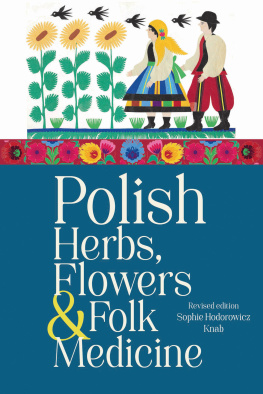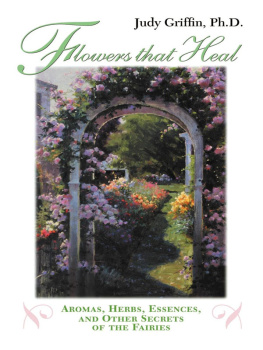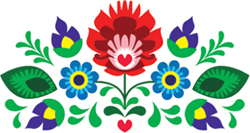
Polish
Herbs,
Flowers
& Folk
Medicine
Polish
Herbs,
Flowers
& Folk
Medicine
Revised edition
Sophie Hodorowicz Knab
Hippocrene Books, Inc.
New York
Also by Sophie Hodorowicz Knab:
Polish Customs, Traditions and Folklore
The Polish Country Kitchen Cookbook
Wearing the Letter P: Polish Women as Forced
Laborers in Nazi Germany, 1939-1945
2020 Sophie Hodorowicz Knab
All rights reserved.
Interior design by Acme Klong Design and K & P Publishing/Barbara Keane-Pigeon.
See photo credits .
For further information, contact:
Hippocrene Books, Inc.
171 Madison Avenue
New York, NY 10016
www.hippocrenebooks.com
ISBN: 978-0-7818-1414-0
Previous edition ISBN: 978-0-7818-0786-9
Cataloging-in-Publication Data is available from the Library of Congress.
Printed in the United States of America.
CONTENTS
CHAPTER 1
HERBS AND FLOWERS THROUGHOUT THE CALENDAR YEAR
CHAPTER 2
PLANTS AND FLOWERS IN TRADITIONAL POLISH WEDDINGS
CHAPTER 3
A BRIEF HISTORY OF MEDICINE AND HEALING ARTS IN POLAND
CHAPTER 4
POLISH GARDENS OF THE PAST
CHAPTER 5
GLOSSARY OF POLISH HERBS, SPICES, PLANTS, TREES AND FLOWERS
CHAPTER 6
FROM MY GARDEN TO YOURS
SIDEBARS 
ACKNOWLEDGEMENTS
Thanks to the wonderful people at Hippocrene Books, particularly Priti Gress, editor, and Barbara Keane-Pigeon, production manager, I am happy to be able to offer you this new and revised edition of Polish Herbs, Flowers and Folk Medicine. I am grateful to all the individuals who wrote to me asking about the out-of-print book. You inspired me to bring the book back into being. My thank you to Elliott Hutten for her beautiful illustrations; Karol Olkowski for technology help; Diane Rzepkowski Chodan for gifting me with her family copy of the book Kobieta Lekaraka Domowa; Rev. Czesaw Krysa for his insights, his contributions, and creating a faith-based haven for the expression of Polish customs and traditions; Andrew Gobiowski, a truly dedicated promoter of Polish history and heritage; and Diane Woloszyn who shares all she has and all she knows, always.
AUTHORS NOTE
It has been some twenty-odd years since Polish Herbs, Flowers and Folk Medicine was published. And yet, as Polish folklorist Tadeusz Seweryn so aptly states in the opening chapter of this new, revised edition of the book, the revival of tradition across the centuries testifies to its vital force. I have never seen such a wonderful renewal of interest in Polish history, culture, and traditions as I do at this moment in time. So many people of Polish descent are searching for connections to their ancestors through genealogy, recipes, and customs throughout the calendar year. As one young woman wrote to me: Im trying to learn more about my heritage. Another wrote with a particular interest in folk medicine. Writers wanted background information for their novels. Others simply wanted to know what flowers would have been growing in their grandmothers and great-grandmothers gardens. I couldnt ignore their requests. We need to know who we are and where we come from. If there is one purpose in my writing life, it is to share the rich culture and history of Poland with others.
If you would like to visit my website where I write more about the history and traditions of Poland, please join me at: sophieknab.com.
Sophie Knab
Grand Island, NY
A NOTE ABOUT MEDICINAL PLANTS:
All suggestions within this book are made without guarantee on the part of the author or Hippocrene Books. The information in this book is chiefly for reference and education. The reader should be aware that any plant substance, whether weed or flower, is a complex chemical compound and whether used as food or medicine, internally or externally, may cause an allergic reaction. Any references to the use of a plant should not be construed as medical advice and is not intended as a substitute for guidance and instruction from a physician.
CHAPTER 1
Herbs and
Flowers in
Everyday Life
Tradycja jest jak lustro, w ktrym odbijaj sie wieki. Tradycja jest jak drzewo, ktre korzeniami swymi siga gboko w grunt rodzimy. Zdarzao si nieraz e konary tego dzewa uschy, a pien poorany zmarszczkami staroci przez wiele lat nie zdradza utajonego w nim ycia. A oto spod jego ne pozr martwej kory wychiliy si ku wiata pczki, ktre rozwiney si w ziele i kwiaty. To wasnie odradzanie si tradycji wiadczy o jej sile ywotnej.
Tradition is like a mirror which reflects the centuries. Tradition is like a tree whose roots reach deeply into the native soil. It happens sometimes that the branches of this tree wither, and the trunk furrowed with the wrinkles of aging does not betray its latent life for many years. And yet, from under its pretense of dead bark, buds emerge to the world, which bloom into greenery and flowers. It is this revival of tradition that testifies to its vital force.
Tadeusz Seweryn, Polish folklorist and ethnographer
I n 1933, Polish archeologists unearthed the remains of an ancient settlement that provided much information about Polands early development. It was called Biskupin and is located in the Bydgoszcz province. Careful reconstruction dated the civilization back to 550-400 B.C. From these discoveries, it became clear that farming and raising cattle were the chief occupations of the inhabitants. They grew wheat, barley, rye, and beans. The archeologists determined that these early peoples of Poland used herbs not only to flavor foods but also as medication. Twenty different herbs were identified at the site. Among those listed were mullein, asarum, burdock, wormwood, coltsfoot, mallow, and tansy. There was also no doubt that these early Slavs had cults revering plants, animals, and trees and attributed great magic, strength, and power to them. Trees were worshipped as divine. The forests were considered the dwelling place of the gods. Worshipers laid offerings before the trees and used their branches in rituals throughout the changing cycle of the seasons.
In 966, Polish King Mieszko accepted Christianity for the people of his lands. The old pagan practices of worshiping plants and trees were not eradicated but rather became intermingled with the new religion and persisted throughout the centuries. Even as late as the 16th century, the authorities were still attempting to put a stop to the custom of stripping the forest to celebrate the onset of spring without much success. By the late 1800s, when folklore scholars were documenting the folk life of the peasants, they found that very ancient practices tied to primitive beliefs about plants and trees, were still abundantly evident. It was a continuous cycle that began in early spring which saw groups of young girls parading through their villages with a budding young tree called a
Next page














